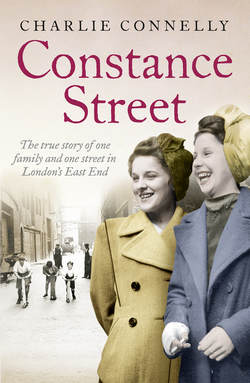Читать книгу Constance Street: The true story of one family and one street in London’s East End - Charlie Connelly, Charlie Connelly - Страница 14
Chapter Seven
ОглавлениеThe junior Silvers seemed to share their father’s instinct for opportunity. In 1859 the company staged a demonstration of submarine telegraphy, the use for which they felt their gutta-percha works might be best disposed. Two hundred ‘gentlemen’ travelled down the river by boat to see how undersea telegraph cables coated in gutta-percha would be totally protected from water damage. One contemporary newspaper report noted:
‘The company assembled had the pleasure of inspecting the extensive factory of Messrs Silver at Silvertown where they carry on their India-Rubber Works, which are not only remarkable for their extent but also for their arrangement both mechanically and socially. Besides the master-mind, there are a chaplain, a surgeon, a sick club and a school for the children of the workmen, and the evenings of the men and their families are enlivened and rendered instructive by lectures from men of first-rate ability.’
How enlivening and instructive the lectures were considered by men at the end of a long, hard, dirty, noisy day is possibly open to debate. Charles Dickens’s Household Words magazine waved the flag in 1862, declaring that ‘the tall chimney by the river-side at Woolwich, marks, in fact, not only a place of mechanical industry, but the centre of a cheerful, wholesome influence; and this is, happily and honourably, becoming true now-a-days of many a tall chimney in our land of factories’.
Yet not everyone was swayed by the PR of progress. As the Chelmsford Chronicle reported in June 1859, three months after the initial glowing report of a workers’ utopia above, ‘the system of sewerage now in course of formation by the West Ham Board of Health will, when completed, materially improve the sanitary state of Plaistow Marsh, which during the winter or rainy seasons, from the amount of mortality among the inhabitants, exhibits evidence of its insalubrity’.
Silvertown was far from a sun-kissed utopia of industry in which the benevolent industrialist walked arm-in-arm with the healthy, ruddy-cheeked labourer through leafy streets breathing air thick with the scent of lavender and apple-blossom. Dickens himself visited the area and noted how the reclaimed land was some seven feet below the Thames’s high-tide level, going on to describe basic houses of four rooms containing several families with no drainage or amenities that were ‘mere bandboxes placed on the ground’. The streets, which were unsurfaced tracks, were little more than a series of deep puddles of brown mud where the local doctor, he continued, ‘is drawn to wearing sea boots and the clergyman loses his shoes through neglecting to take a similar precaution. The national school is a wooden lean-to where the mistress, when it rains, conducts the lessons from beneath an umbrella to protect herself from the leaking roof.’
That clergyman, a Rev. H. Douglas, was deeply troubled by the poverty of the area and had written about it in a letter to The Times published on Christmas Day 1859.
‘The district is occupied chiefly by works for transforming the refuse of slaughterhouses into manure and for the manufacture of vitriol and creosote,’ he wrote. ‘The habitable areas consist of islands of liquid filth, surrounded by stagnant dikes … Poverty alternates with fever. Every gust of prosperity brings an influx of strangers to the neighbourhood; every succeeding stagnation overwhelms the district with destitution. At the time of writing the cry for food and fire is frightful. Amongst other distressing cases of illness three whole families are down with fever and on one day recently no less than seven accidents occurred.’
Perhaps cowed by these reports, in 1863, as Silver’s waterproofing business really began to take off, the expanding company began to invest a little more in creating its own community. The architect S.S. Toulon completed St Mark’s Church to a design that divided opinion: Pevsner described Toulon’s church as being ‘as horrid as only he can be and yet of a pathetic self-assertion in its surroundings’. The church was flanked closely to the north by the new North Woolwich Railway, re-routed around ‘The Vic’ because its initial, pre-dock route interfered with both shipping and the railway timetable. The design of St Mark’s may not have pleased everyone but the church would go on to establish itself at the heart of the Silvertown community. Its Normanesque steeple, as imposing as it was curiously squat, would become a familiar landmark to locals and those arriving in Silvertown by train, even as it became surrounded in the following years by a forest of belching chimneys and gas and oil holders.
A year after the consecration of the church, three more streets appeared immediately opposite the Silver works. Andrew Street and Constance Street jutted north into marshy fields, while Drew Road bisected them both from east to west. The houses in these streets were a step up from the basic workers’ cottages nearby: they had, according to a report at the time, ‘bay windows, well-lighted stairs and a grate as well as a copper in the washhouse’. Some had been constructed as shops and commercial premises too.
At the southern end of Constance Street stood the Railway Tavern, an imposing, sturdy public house which had opened in 1855 under the tenancy of William Owston, while opposite was constructed Silvertown Station, opened in 1863, the same year as Constance Street, meaning that, barely a decade since humanity arrived in the region, Silvertown had a name, a church, a pub and a railway station: the four basic tenets of a community were in place. All Silvertown needed now was a population.
